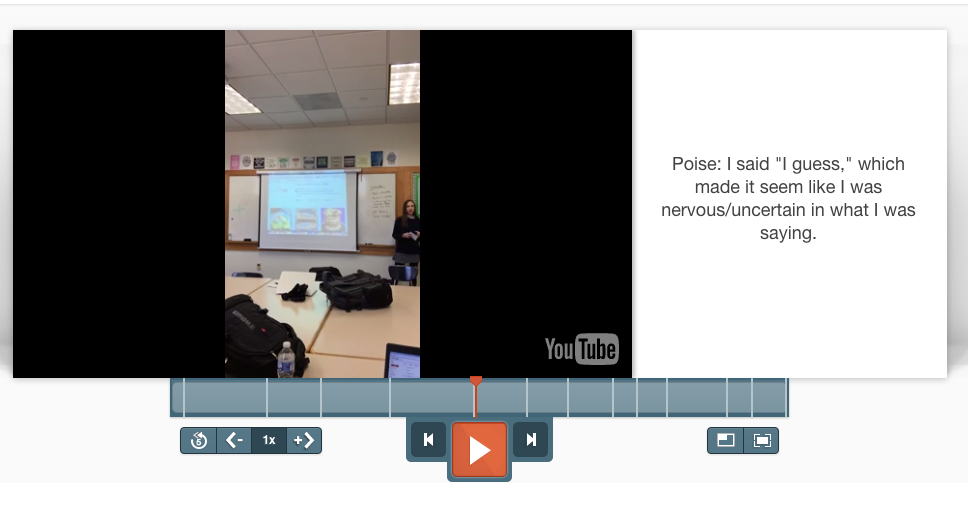Traditionally, students submit their work on an assignment, after which the teacher gives feedback on that work and assigns that student a grade. Every once in awhile, we build reflection into the next step of the process and ask students to make corrections or comment on the feedback.
But, is this truly authentic reflection or are students swayed by the teacher's thoughts? When we, as teachers, give feedback and then ask students to reflect on this, are we losing some of the student's voice and independent thinking?
Let’s take public speaking, for a moment.
"Public speaking provides a wonderful opportunity for self-reflection," says English Teacher Kerry Hosmer.
Hosmer and I teamed up to leverage the power of technology to enable students to take their self-analysis to the next level, and here was our big goal: we wanted to have students initiate and guide the reflective process. Here’s how we did it.
Anchoring the Curriculum
Through this effort, we wanted the teacher to have a chance to hear a student's self-reflection before making an opinion. As educators, we are always promoting creativity and the importance of students asking the questions instead of always providing them with the prompts—so in this project, we required students to break down and analyze their work independently.
The PVLEGS (Poise, Voice, Life, Eye Contact, Gestures, and Speed) delivery approach (developed by Erik Palmer) serves as the anchor for the Public Speaking course. Poise, Voice, Life, Eye Contact, Gestures, and Speed become fundamental attributes that each speaker must work on, along with the construction of the assigned speech. These components are critical to student success, but processing both information and delivery simultaneously can be quite challenging. So, Mrs. Hosmer explains why self-critique is key:
"Students remain in tune with the internal—their nerves, the key points in their heads that they must address, and usually a time measurement that they have to meet. The self-critique allows a more thorough reflection on performance as students step back from the internal nerves and review the actual delivery. What effective changes in tone took place? Was the pace appropriate for the speech? Did their gestures enhance the delivery or distract from the message? Did they truly connect with their audience through eye contact, or did the speech get delivered to the floor?"
Students in public speaking explored how to capture and maintain audience attention. They learned the importance of a confident and poised delivery. From there, students moved into examining the structural approach to writing an original speech. Students were given the freedom to choose their own topic and speak about something they are passionate about.
Picking the Tech Tool*
After writing and practicing speeches, students were ready to present in front of the class. And—ready for the big secret?—students used their phones to capture a video recording of their in-class presentation. We introduced students to Zaption, a web app that turns a video into an interactive experience by inserting text, quizzes, and discussions. Though the tool is often aimed at teachers looking for a way to engage and monitor students watching instructional videos, we decided to allow students to do the authoring for this exercise.
Using Zaption, students were asked to address the following in their self-critique:
- Focus on PVLEGS delivery attributes.
- Pick four stop points during the speech and, using Zaption, insert text comments to provide your reaction.
- Be specific in evaluative comments. Tag to a specific PVLEGS element as you analyze.
- At the end of the video, reflect on:
- key strengths
- areas that could use improvement
- goals for the next speech

Students' depth of understanding the PVLEGS approach becomes clear through their comments in the Zaption Self-Critique. They must pinpoint deliberate places in order to both celebrate strengths and to set goals for improvement.
Using Zaption, students took ownership over the process of identifying how to take their speeches to the next level. The assignment promotes critical, independent, and reflective thinking. Consider senior Jessica Vincent’s perspective:
"It was awkward and uncomfortable at first, but really beneficial. You don't usually get to see how you look to other people, especially during a speech in front of the class. You're nervous and focused on what you need to say, so you don't really get to pay attention to what others are seeing. Zaption was easy to use. It forced me to pay attention to the entire video since we had to comment at various points."
Expanding Reflection and Critique Activities
In the future, students will use Zaption to review a classmate's speech. A student speaker will insert specific text slides along their speech recording and incorporate targeted questions for review. This next level will open up constructive dialogue between classmates, as well as reinforce the understanding of these critical components of the course.
Reflection offers a critical tool for both students and their teachers who are guiding them—especially if the right technology is involved. Understanding can be even more closely assessed, and the process opens up a one-on-one dialogue that ultimately results in further growth in the classroom.
*Update: Zaption was recently acquired so it is no longer a tool that we can use in the education space. I would now recommend using EDpuzzle for this activity, a tool that serves the same purpose as Zaption did. EDpuzzle is extremely user-friendly so creating this activity for students requires very little technical instruction and keeps the focus on the learning task, one of the first things I assess in examining new edtech. Here is a link to a Public Speaking critique, created with EDpuzzle.


